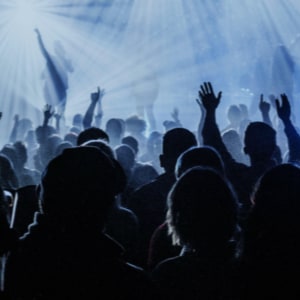At their first Bay Area show ever, legendary U.K. anarcho-punks the Mob exhibited just how much history can contort past perception. While the band delivered a killer set at the Oakland Metro Opera House, both their performance and presence exemplified that not all anarcho-punk was patchy jackets and oi-oi-oi Oct. 21.
Although the band had been broken up for almost 30 years, last year, they suddenly reformed with their three original members. After a some U.K. dates, and a precious few U.S. peformances, the band announced a surprise Bay Area show much to the area's rather large anarcho/crust/smelly punk population's joy. Although many attendees seemed to try to downplay their excitement, it seemed that expectations were pretty high for the band that while being fairly well known, always seemed more obscure and illusive than their Crass and Spiderleg Records labelmates.
As soon as the band took the stage, it became abundantly clear how different original anarcho-punk was from its modern caricature. While the audience was almost uniformly dressed in spikes, patches and leather, the band themselves were dressed in a more reserved fashion, clad in normal jeans and nondescript sweaters. Even their hair was little more than slightly shaggy cuts. Referencing vintage pictures of the band also shows that even back in the day, the band dressed more akin to the norm than Subhumans style spikes and grime.
The clothing contrast acted as harbinger for the music itself. Stereotypically, anarcho-punk is often thought of as sounding simple, raw and atonal, with most people using Crass as sonic buoys. However, on their sole LP, Let the Tribe Increase, the Mob never really fit that mold.
While Crass were screaming, while the Subhumans were chanting and while Amebix were smashing, the Mob seemed to pull from the same source as their contemporaries, but applied their music in a more existentialist sense. Instead of directly attacking Margaret Thatcher, the band would attack the thing that she represented. Instead of decrying the Falkland wars, the band would lament the urge in man to war at all.
Likewise, the music itself was more abstract. While the band had an aggressive tempo, unlike their contemporaries, they would create a cold, distant sound, at times as referential to Joy Division and Bauhaus as to the more immediate barking of the time. As the band stated in their (near) discography comp Let the Tribe Increase following the group's breakup, the band felt that listeners felt that the band was pure moroseness while they felt their gigs were laces of education, but joy as well.
The live show proved that the band was right. Although the played the majority of Let the Tribe Increase, and although the band retained their spacier, colder texture, the songs were significantly revved up from their studio counterparts. While the studio recordings seem to be songs meant for solitary listening, live the band's abstract refrains became group chants, with audience members crowding around the mic to shout out the refrain.
The newly energized take on the songs made them seem more solid as well. Riffs thwomped harder. The drums drove faster. The effect of which was that the dynamics of the songs were increased. When vocalist Mark Wilson, who sounded great, called out the refrain to "Another Day, Another Death," it slammed twice as hard as the studio recordings, coming off the tail end of a roller coaster riff.
Most surprising was the live take on the legendary anarcho anthem "No Doves Fly Here." Live, the song started out as a quiet twinkling only to build higher and higher until it erupted with the outro jam that felt as much punk as it did the explosive jam sessions of Funkadelic.
The band also played a new number called "Rise Up" that fit squarely into the band's catalogue. A fairly rapid number, the song demanded self reliance and assuredness, instructing the listener to fight against social/political injustices instead of merely lamenting the status quo. Often bands' messages get lost in time due to interpretation, journalists (*ahem*) and cluttered memory. When the Mob played the Bay Area, not only did they make their message and purpose quite clear, they made it stronger than it ever has been before.
Random notes:
-Oh man, in the past four years, the Bay Area has seen shows by so many awesome reunited O.G. U.K. anarcho bands that never toured the U.S. it is crazy. Amebix! Damn! Zounds!Oh snaps! Steve Ignorant! Yowza! Antisect! Sweet mama jamma! And now the Mob! Crickey! Who's next? Flux?! Omega Tribe?!! RUDIMENTARY PENI?!!!! Oh, I just couldn't take it.
-"Hey, uh, John, was Pete the Roadie workin' the stage?" OF COURSE PETE THE ROADIE WAS WORKING THE STAGE. WHY DO YOU THINK HIS NAME IS WHAT IT IS?!
-Whenever I see an O.G. English band, I think to myself "Wow, they really do look English." Can I say that? Is that racist?
-There were opening bands, but none of them announced their names and they played out of order of the flier. I wanted to write about them, but I didn't know who was who! Say your band's name, people!
-I often poke fun at anarcho-crust punk and its participants, but I will say this, in the realm of darker arts and expression, the genre does make some of the neatest, most intellectually stimulating sounds and imagery. Check the cool wax.
-As I overheard at the show, anarcho punk rockers genially express disdain for the Jersey Shore because the participants spend excessive amounts of time focusing on their clothes, getting really drunk, getting into fights for no good reason and never seem to really do anything. Whereas anarcho punk rockersâ¦
